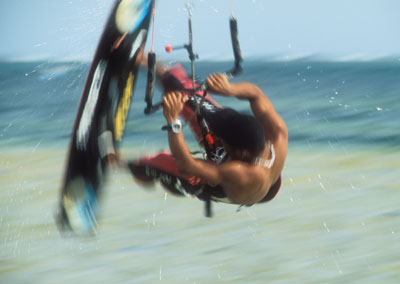Kite-boards must be moving at above their planing speed to remain above the water, so getting near the action as a photographer can be challenging. Although some opportunistic work can be done from a beach, a pier or a boat, the best results are probably obtained when working in co-operation with the kite-boarder who may be able to make a series of passes at an ideal distance from the camera. The time of day and the consequent angle of the light may also be prearranged under these circumstances. If local conditions allow it, one approach is to work in shallow water near the beach.
 Waterproof camera equipment is more or less essential. Standing in shallow water is hazardous because it is all too easy to lose one's balance and fall over, or drop an item of equipment. Water may be thrown up as waves break or pass over the photographer's legs, and the passing kit-boarder will certainly be followed by a plume of spray.
Waterproof camera equipment is more or less essential. Standing in shallow water is hazardous because it is all too easy to lose one's balance and fall over, or drop an item of equipment. Water may be thrown up as waves break or pass over the photographer's legs, and the passing kit-boarder will certainly be followed by a plume of spray.
Another difficulty with kite-boarding photography is that the kite itself is a considerable distance from the kite-boarder, and it may prove very difficult to incorporate the kite into the image. This leaves the kite-boarder isolated and dependent upon a couple of wires which disappear out of the image. Viewers who are unfamiliar with the sport may find this confusing. The only way to incorporate the kite is to view the action from behind the board, looking downwind to the kite. This viewpoint is difficult, but not impossible, to achieve.
Light is important as always. Backlit spray glows beautifully and may transform an ordinary picture in to something special. However, it can be very difficult to get the direction of both the wind and the light correct in relation to the photographer's viewpoint. Working from a stationary boat gives more flexibility from this point of view. However, the photographer then has to contend with the motion of the boat which inevitably makes the use of a telephoto lens more difficult.






